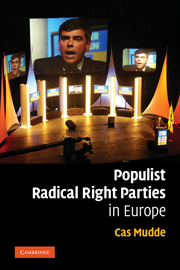Book contents
- Frontmatter
- Contents
- List of tables
- Acknowledgments
- List of abbreviations
- Introduction
- Part I Concepts
- 1 Constructing a conceptual framework
- 2 From conceptualization to classification: which parties?
- Part II Issues
- Part III Explanations
- Appendix A Populist radical right parties
- Appendix B Questionnaire
- Bibliography
- Index
2 - From conceptualization to classification: which parties?
Published online by Cambridge University Press: 22 September 2009
- Frontmatter
- Contents
- List of tables
- Acknowledgments
- List of abbreviations
- Introduction
- Part I Concepts
- 1 Constructing a conceptual framework
- 2 From conceptualization to classification: which parties?
- Part II Issues
- Part III Explanations
- Appendix A Populist radical right parties
- Appendix B Questionnaire
- Bibliography
- Index
Summary
Though formal definitions or derivations based on the history of ideas largely failed to provide a convincing concept for ‘right-wing extremism’, research work on political parties of the right has not had serious problems in selecting appropriate cases.
(Von Beyme 1988: 3)Introduction
Both the academic and public debate about the “extreme right” lends credence to Von Beyme's assertion that we know who they are, even though we do not know exactly what they are. However, I fundamentally disagree with the belief that “the extreme right is easily recognizable” (Anastasakis 2000: 4). Practice certainly reveals that we do not know who they are (also Mudde 2000a): while there is consensus with regard to the inclusion of some parties in this category, the proper classification of many others remains contested. Indeed, there are some special circumstances that make the implications of this assumption especially problematic for this particular party family.
Some scholars consider the Scandinavian Progress Parties to be the first of the recent wave of “right-wing populist” parties (e.g. Decker 2004; Betz 1994), whereas others exclude them from their analysis on the grounds that they are not “extreme right” (e.g. Mudde 2000a). Similarly, while the Italian Lega Nord (Northern League, LN) is included in most comparative studies of the populist radical right party family, at least one prominent scholar (Ignazi 1992; 2003) has consistently excluded it. The confusion with respect to classifying the parties in Eastern Europe is even more striking.
- Type
- Chapter
- Information
- Populist Radical Right Parties in Europe , pp. 32 - 60Publisher: Cambridge University PressPrint publication year: 2007
- 1
- Cited by



